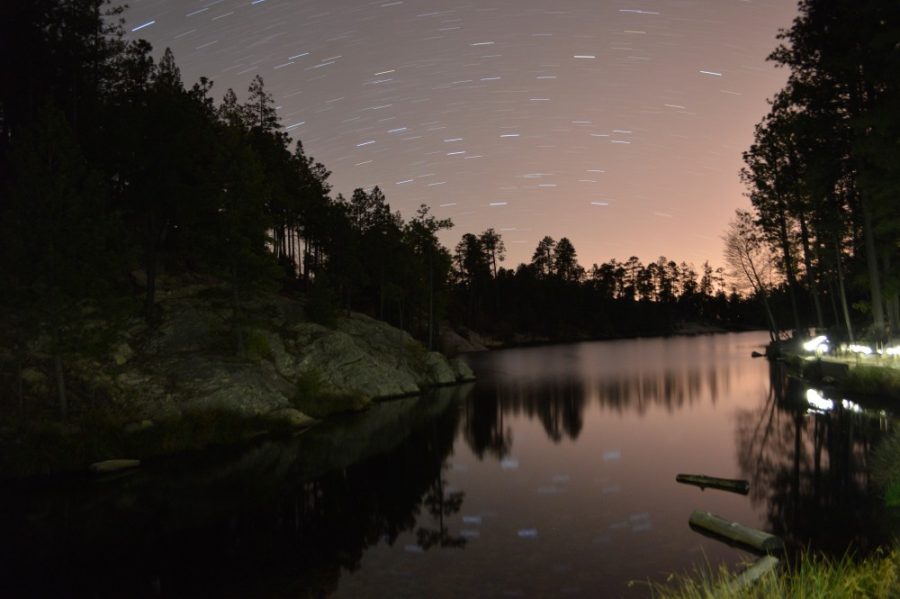Many people in Arizona are in the dark about a little-known environmental issue: unpolluted dark skies, which are a luxury enjoyed by the residents of Flagstaff.
The people of larger cities, including Tucson and Phoenix, have not seen a night sky with all its stars. Light pollution from storefronts, homes and cars affects the visibility of the sky from dusk until dawn.
“There now exists a generation of people who have not seen a dark night sky before, who have not clearly seen the Milky Way, parts of our galaxy, the aurora and meteor showers,” said Adam Block, the manager of Mount Lemmon’s SkyCenter, north of Tucson.
Block said that light pollution is paramount to a loss of the Earth’s identity in the universe.
“We have this loss of our place in the universe,” he said. “That’s a loss of identity and that might actually be something people will regret losing someday.”
Bright, human-made lights create a real “boogeyman” that lurks beneath the night sky. Some cities have taken action to cut back on their light emissions.
Flagstaff is famous for its recognition as the first International Dark Sky City. Sedona, Arizona followed suit in 2014. Tucson is not considered a Dark Sky City, ccording to the International Dark Sky Association,
Dark Sky cities are ones that demonstrate exceptional dedication to the integrity of the night sky. This might include lighting codes, dark sky education and citizen support. Flagstaff is the prime example of a Dark Sky city. During a drive between Phoenix and Flagstaff on a cloudless night, Orion walks Sirius the dog across the horizon and the Little Dipper comes into focus.
Twinkle, twinkle, little star: How I wonder where you are
The National Park Service champions the purity of the night skies. Pollution affects the night skies of national parks, which threatens diversity, diminishes visibility and mitigates human health.
Light pollution affects the visibility and aesthetic quality of the night sky. Preliminary data comparing Casa Grande Ruins National Monument and Saguaro National Park with the relatively pristine Wupatki National Monument and Petrified Forest National Park indicated that nearby Phoenix and Tucson should consider cutting back on their light use. When compared to the pure horizons of Wupatki, city horizons appeared splotched in red light. This light compromises the visibility of the horizons in both the cities themselves and their surrounding areas.
“People don’t like change,” said Scott Kardel, a member of the International Dark Sky Association. “Period.”
But change may be necessary for the sake of both environmental and human health.
“It’s important to remember the context that almost all life has this embedded 24 hour cycle in it,” Kardel said.
I wish I may, I wish I might, have the wish I wish tonight
The National Park Service declared light pollution an issue of environmental concern in 2002. Since then, it has been researching the skies through its Night Sky Program. In Arizona, Flagstaff has one of the least polluted horizons near a city.
“It’s kind of the standard for how you want to do it, you know, if you’re worried about night skies,” said Dan Duriscoe, a scientist researching photometry for the National Park Service. “We haven’t run the same analysis on Phoenix and Tucson, but I would suspect that both Tucson and especially Phoenix would be much brighter.”
This nearby light can obscure the visibility of the night sky. Block runs regular outreach programs on Mount Lemmon to show people the effects of pollution on the night sky.
“If you have someone on the mountain, [they] can see that this is a dark sky, but [they] can see the glow from the nearby city,” he said.
Block and the other astronomers who work in Mount Lemmon’s SkyCenter have found that Tucson’s lights still affects their jobs.
“If it’s too bright, I can’t show people the stars,” Block said.
Like a diamond in the sky, when tiny diamonds become blazing suns
Light pollution can creep from the horizons into the homes of citizens. Electric glow, particularly from blue lights, can affect human health.
Many people attempt to sleep with lights from other homes or muted TVs and this light can interrupt their sleep cycle.
“We’re basically giving ourselves something that’s an equivalent to jet lag,” Kardel said.
Safety is the main reason many people balk at the idea of cutting back on lighting. The initial dimming of light can be a shock.
“People will want more light because they’re used to more light,” Duriscoe said. “If they get less light, they’ll get used to it.”
Cities can consider techniques such as shielding streetlights or home floodlights, curfews and amber-colored lights to cut back on their emissions.
“I think today we’re seeing a trend of using more light in terms of brightness,” Duriscoe said.
He believes that the intensity of city lights is the main problem. Duriscoe does not think that we need to eradicate every single light source. Making them dimmer might just do the trick.
“Just using less of it in the first place can make a difference,” Duriscoe said.
Kardel envisions technology as being beneficial in the future. Instituting motion sensors in parking lots would decrease light use at night when few people are awake.
As lighting continues to obscure the skies, the future remains uncertain for researchers such as Duriscoe and activists like Kardel and Block.
The universe is an expansive infinity of black quilting. Each star is like a glowing pinprick in that quilt, up above the world so high.
“It’s a beautiful thing to see the rest of the universe,” Block said. “The Earth is just a very small part of that.”
Follow the Daily Wildcat on Twitter.









